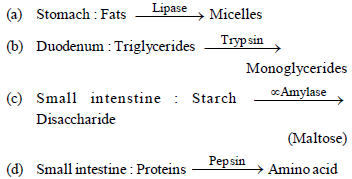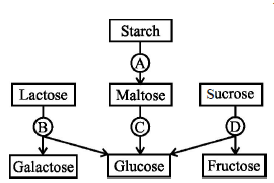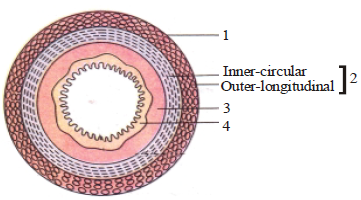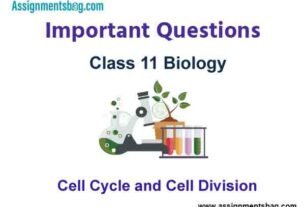Please refer to Digestion and Absorption Class 11 Biology Important Questions with solutions provided below. These questions and answers have been provided for Class 11 Biology based on the latest syllabus and examination guidelines issued by CBSE, NCERT, and KVS. Students should learn these problem solutions as it will help them to gain more marks in examinations. We have provided Important Questions for Class 11 Biology for all chapters in your book. These Board exam questions have been designed by expert teachers of Standard 11.
Class 11 Biology Important Questions Digestion and Absorption
Objective Questions
Question. Teeth of adult man, not present in milk dentition are
(a) molars
(b) premolars
(c) canines
(d) incisors
Answer
B
Question. Which of the following is a freely movable muscular organ that is attached to the floor of the oral cavity by the frenulum?
(a) Jaws
(b) Teeth
(c) Tongue
(d) Salivary glands
Answer
C
Question. ____ are needed in the diet as components of teeth and bone, regulators of acid-base balance and water balance, and parts of certain enzymes.
(a) Carbohydrates
(b) Fats
(c) Minerals
(d) Nucleic acids
Answer
C
Question. The sphincter of Oddi is present between
(a) oesophagus and cardiac stomach.
(b) pyloric stomach and duodenum.
(c) hepatic duct and cystic duct.
(d) hepatopancreatic duct and duodenum.
Answer
D
Question. The number of salivary glands present in human beings is
(a) 5 pairs
(b) 4 pairs
(c) 3 pairs
(d) 2 pairs
Answer
C
Question. Function of gall bladder is
(a) storage of bile.
(b) formation of enzymes.
(c) synthesis of bile.
(d) formation of bile salts.
Answer
A
Question. Which of the following is the structural and function unit of the largest digestive gland?
(a) Kupffer cells
(b) Hepatic lobules
(c) Glissons capsule
(d) Crypts of Lieberkuhn
Answer
B
Question. The substrate for amylase is
(a) proteins
(b) fats
(c) starch
(d) cane sugar
Answer
C
Question. Salivary amylase is also known as
(a) ptyalin
(b) gastrin
(c) glyoxylase
(d) pepsin
Answer
A
Question. Maltase converts
(a) maltose to glucose at pH greater than 7.
(b) maltose to glucose at pH lesser than 7.0.
(c) maltose to alcohol.
(d) starch to maltose at pH higher than 7.0.
Answer
A
Question. The disaccharidases are secreted with
(a) saliva
(b) gastric juice
(c) intestinal juice
(d) pancreatic juice
Answer
C
Question. Enzyme trypsin is secreted by
(a) duodenum
(b) liver
(c) pancreas
(d) stomach
Answer
C
Question. Milk protein is acted upon by a gastric enzyme in infant mammals. The enzyme is ___________.
(a) rennin
(b) caesinogen
(c) pepsinogen
(d) pepsin
Answer
A
Question. Oxyntic cells are located in
(a) Islets of langerhans.
(b) gastric epithelium and secrete pepsin.
(c) kidneys and secrete renin.
(d) gastric epithelium and secrete HCl.
Answer
D
Statement Type Questions
Question. How do nutrients, absorbed by the small intestine, travel to the individual cells of the human body?
(a) The nutrients are absorbed from the small intestine into the blood and move through the circulatory
system to the body cells.
(b) The nutrients move from the small intestine directly to the liver and then move through the lymphatic
system to the body cells.
(c) The small intestine forces the nutrients into the kidneys, where the nutrients are then dissolved in
fluids used by the body cells.
(d) The body cells send nerve impulses indicating a lack of nutrients to the small intestine, and the small
intestine sends the nutrients back to the cells.
Answer
A
Question. Which of the following statements is correct regarding enterokinase?
(a) It is a hormone that prevents the secretion of gastric juice.
(b) It is an enzyme that activates the enzymes of pancreatic juice.
(c) It is an enzyme that activates the proteolytic enzymes of succus entericus.
(d) It is a hormone that prevents the secretion of pancreatic juice.
Answer
C
Question. Which of the following is not the function of HCl in stomach?
(a) Breaking down proteins into peptones.
(b) Killing the bacteria ingested with food and drinks.
(c) Promoting the formation of pepsin.
(d) Softening fibrous food elements.
Answer
A
Question. What will happen if bile duct gets choked ?
(a) Faeces become dry.
(b) Acidic chyme will not be neutralized.
(c) There will be little digestion in intestine.
(d) Little digestion of fat will occur.
Answer
D
Question. Which of the following statement is true ?
(a) Pepsin cannot digest casein.
(b) Trypsin can digest collagen.
(c) Pepsin cannot digest collagen.
(d) Chymotrypsin can digest casein.
Answer
D
Question. Which of the following is not the function of digestive system?
(a) It allows your body to get the nutrients and energy it needs from the food you eat.
(b) It breaks down large food molecules into smaller molecules that can be used by cells.
(c) It converts foods to larger substances that can be absorbed and used by the cells of the body.
(d) It converts food into soluble and diffusible products that can be absorbed by the blood.
Answer
C
Question. Which of the following statements are correct regarding jaundice?
(i) It indicates liver damage.
(ii) It involves infrequent elimination of dry stool.
(iii) It involves yellowing of skin and eyes.
(iv) It increases absorption of food.
(a) (i) and (ii) only
(b) (i) and (iii) only
(c) (i), (ii) and (iii) only
(d) (i), (iii) and (iv) only
Answer
B
Matching Type Questions
Question. Identify the correct set which shows the name of the enzymes from where it is secreted and substrate upon which it acts
(a) Pepsin – Stomach wall – Protein
(b) Ptyalin – Intestine – Maltose
(c) Chymotrypsin – Salivary gland –Lactose
(d) Ptyalin – Pancreas – Lipid
Answer
A
Question. Which one of the following is the correct matching of the site of action of the given substrate, the enzyme acting upon it and the end product?

Answer
C
Question. Match column I (organs) with column II (functions) and choose the correct option.
| Column-I (Organs) | Column-II (Functions) |
| A. Mouth | I. Reclaims water and salts |
| B. Stomach | II. Carries out most of the digestion and absorption of nutrients. |
| C. Small intestine | III. Releases amylase enzyme that break down carbohydrates. |
| D. Large intestine | IV. An acidic compartment that begins to break proteins into larger polypeptides. |
(a) A – I; B – II; C – III; D – IV
(b) A – III; B – IV; C – II; D – I
(c) A – II; B – III; C – I; D – IV
(d) A – IV; B – I; C – II; D – III
Answer
B
Question. Match column I (food type) with column II their (enzymes) and choose the correct option.
| Column-I (Food type) | Column-II (Enzymes) |
| A. Starch | I. Nucleases |
| B. Protein | II. Lipase |
| C. Fats | III. Amylase |
| D. Nucleic acid | IV. Trypsin |
(a) A – III; B – IV; C – II; D – I
(b) A – I; B – II; C – III; D – IV
(c) A – II; B – III; C – IV; D – V
(d) A – IV; B – I; C – II; D – III
Answer
A
Question. Match the following digestive processes given in column I with their correct description given in column II and then choose the correct option.
| Column-I (Digestive processes) | Column-II (Description) |
| A. Ingestion | I. Elimination of digestible solids. |
| B. Mechanical digestion | II. Enzymatic degradation of food stuffs into simpler molecules. |
| C. Chemical digestion | III. Taking food into the digestive systems |
| D. Defecation | IV. Chewing, mixing, churning and segmentation of food. |
(a) A – I; B – II; C – III; D – IV
(b) A – IV; B – I; C – II; D – III
(c) A – III; B – IV; C – II; D – I
(d) A – I; B – III; C – IV; D – II
Answer
C
Question. Which of the following substances involved in organic molecule digestion is correctly matched with their descriptions?
(a) Salivary amylase- It begins lipid digestion in mouth.
(b) Trypsin- It emulsifies fats for digestion.
(c) Bile- It digests proteins in small intestine.
(d) Maltase- It is a brush border enzyme that acts on disaccharides.
Answer
D
Diagram Type Questions
Question. The given flowchart shows the fate of carbohydrate during digestion in the human alimentary canal. Identify the enzymes acting at stages indicated as A, B, C and D.

(a) A= amylase, B = maltase, C = lactase, D = invertase
(b) A = amylase, B = maltase, C= invertase, D= lactase
(c) A = amylase, B = invertase, C = maltase, D= lactase
(d) A = amylase, B = lactase, C = maltase, D = invertase.
Answer
D
Question. The given figure shows a section of small intestinal mucosa showing villi. What is the function of structure marked as I in the given figure?

(a) To absorb amino acids.
(b) To carry blood.
(c) To transport fat
(d) To transport glucose
Answer
C
Directions : Refer the given figure and answer the questions. This figure shows the diagrammatic representation of T.S of gut with few structures marked as 1, 2, 3 and 4

Question. Which of the following structure forms glands in the stomach and crypts in between the bases of villi?
(a) 1
(b) 2
(c) 3
(d) 4
Answer
D
Directions for Questions: The given diagram shows the duct systems of liver, gall bladder and pancreas in which few structures are marked as 1.2.3 and 4. On the basis of this figure answer the questions.

Question. Sphincter of Oddi controls the flow of digestive juice by guarding which duct?
(a) 1
(b) 2
(c) 3
(d) 4
Answer
C
Question. Which of the following best describes the role of the structure marked as Y in the given figure?

(a) Serves a minor role in the chemical digestion of fats.
(b) Mucus is secreted to protect the oesophagus from the stomach enzymes.
(c) Digestive enzymes are secreted as food passes from the oesophagus to the stomach.
(d) Connects the mouth to the stomach and has no function in chemical digestion.
Answer
D
Critical Thinking Type Questions
Question. In pancreatic juice, which of the followings are secreted in inactive form as proenzymes ?
(a) Trypsin, chymotrypsin & carboxypeptidases
(b) Pepsin, trypsin and chymotrypsin
(c) Trypsin only
(d) Trypsin and chymotrypsin only
Answer
A
Question. Which of the following is the correct chronological order for flow of food from mouth to anus?
(a) Oesophagus → Stomach → Small intestine → Large intestine
(b) Large intestine → Oesophagus → Stomach → Small intestine
(c) Small intestine → Large intestine →Oesophagus → stomach
(d) Stomach → Small intestine → Large intestine → Oesophagus
Answer
A
Question. From deep to superficial, what are the tunics of the intraperitoneal portions of the alimentary canal?
(a) Serosa, muscularis, submucosa and mucosa
(b) Mucosa, submucosa, muscularis and serosa
(c) Adventia, muscularis, submucosa and mucosa
(d) Mucosa, submucosa, muscularis and adventia
Answer
B
Question. The digestion of butter begins with
(a) saliva
(b) gastric juice
(c) pancreatic juice
(d) intestinal juice
Answer
B

